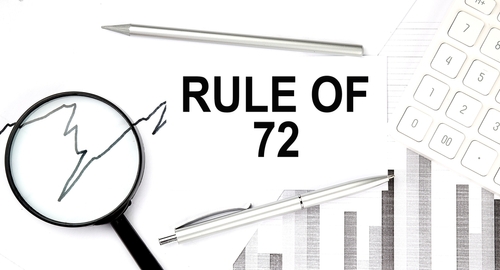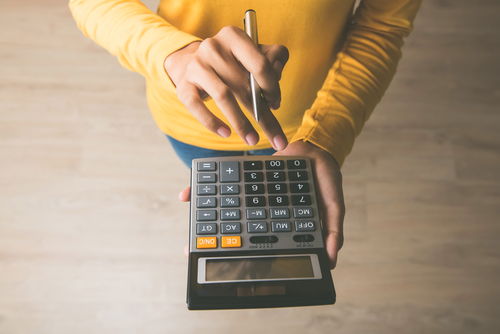Most people invest in real estate with financial goals in mind. Whether you’re earning passive income or saving for retirement, you want to make a profit from your property. However, if you don’t know if your property will be profitable, how do you know if it’s worth the investment? You’ll want to run a few calculations and estimate the profitability of your real estate investment. Keep reading as we discuss the rule of 72 and other rules for investors to live by.

Contents of This Article:
- What Is the Rule of 72?
- How Accurate Is the Rule of 72?
- When Should You Use the Rule of 72?
- Additional Rules for Investors to Live By
- Protect Your Investments With Property Management
What Is the Rule of 72?
The rule of 72 is a basic formula that can help investors estimate how long it will take for an investment to double in value based on the rate of return. To get your estimation, you divide 72 by the annual rate of return. Then, you’ll be left with a rough estimate of how many years it will take for the investment to double in value.

You can calculate the exact amount of time it will take to double your investment price with online calculators and programs. However, using the rule of 72 is helpful if you’re doing mental calculations to get an estimated value. As such, many investors start off using the rule of 72 because it’s easy to comprehend and quick to calculate. Here’s how the formula works.
Formula and Examples for the Rule of 72
There are a few ways to use the rule of 72. You can use it to find the expected years to double and the expected rate of return. However, it’s crucial to note that it only works for investments with compound interest. Here are the formulas:
- Years to Double = 72 / Annual Rate of Return
- Annual Rate of Return = 72 / Years to Double
Here are a few examples if you’re wondering how to use the rule of 72 for your next investment.
- How long will it take for an investment earning 6% to double in value?
- 72 / 6 = 12 years
- How long will it take for an investment earning 9% to double in value?
- 72 / 9 = 8 years
- What rate of return do you need to earn for your investment to double in 4 years?
- 72 / 4 = 18% annual return rate
- What rate of return do you need to earn for your investment to double in 2 years?
- 72 / 2 = 36% annual return rate
As you can see, the two calculations are directly correlated. The higher the annual rate of return, the fewer years it’ll take for your investment to double. Conversely, a lower annual rate of return means it’ll take more years for the investment to double in value.
How Accurate Is the Rule of 72?
It’s pretty clear that the rule of 72 is essential and best used as a simple estimation. That said, it’s more accurate for investments with annual return rates of 6% to 10%. However, lower or higher rates start to give less accurate calculations.

Additionally, the rule of 72 works best for annual compounding rates. On the other hand, if you have daily or continuous compounding interest, 72 won’t be as accurate. To give more accurate calculations, some investors use the rule of 69.3 or the rule of 70 in the same fashion.
Overall, it doesn’t hurt to use the rule of 72 to get a general idea of how your investment property will do. Next, let’s go over some scenarios where you may want to use the rule of 72.
When Should You Use the Rule of 72?
There are a few scenarios where it makes sense to use the rule of 72 to get a quick estimate. Additionally, you can use the rule of 72 for more than just calculating the rate of return or years to double in value. Here are a few other scenarios where it may be helpful to use this simple calculation.
- Planning Large Purchases- If you’re planning a large purchase or saving for a financial goal, you can use the rule of 72 to determine how long it’ll take for your investment to double.
- Evaluate Investments- You can use the rule of 72 to compare potential investments and determine which one will require less time to double in value.
- Understand Debt- Finally, the rule of 72 can be helpful in understanding how debt works. For instance, if your credit card has an annual interest rate of 20%, you’ll still owe double in 3.5 years, even if you make all the minimum payments and spend nothing.
Additional Rules for Investors to Live By
If you’re calculating the profitability of a rental property, there are a few other rules for investors to live by. After all, profitability depends on several factors. Here are a few basic rules and tips to consider while investing in real estate.
- The 50% Rule
- The 1% Rule
- Cash-on-Cash Return
The 50% Rule
One of the most basic rules for investors is the 50% rule to determine the profitability of rental property investment. If you’re following the 50% rule, you will save around 50% of your total gross income to pay for property expenses. After all, you want to profit from your investment. That said, some everyday expenses to plan for include:

- Taxes
- Insurance
- Utilities
- Maintenance
- Washington DC Property Management
- Repairs and Renovations
- Vacancies
So, suppose you’re looking at a property with an estimated rental income of $4,000 per month. In this case, you’d want to set aside $2,000 for property expenses and use the remaining half to pay off your loan and earn income.
The 1% Rule
If you want to purchase a rental property that fits your investment goals, you may use the 1% rule. After all, the purpose of investing is to produce passive income. So, the 1% rule states that the gross income of your investment should at least equal 1% of the purchase price.
Here’s an example of an investment property that costs $160,000.
- $160,000 x 0.01 = $1,600
In this scenario, you would want to find a mortgage with a monthly payment of $1,600 or less and set rental rates at $1,600. Remember that the purchase price includes all taxes, renovations, and associated fees. Overall, the 1% rule is an essential way to ensure that your investment will earn income and cover expenses.
Cash-on-Cash Return
Another one of the most basic rules for investors is calculating the cash-on-cash return. This calculation measures the total returns you made on your investment. You subtract all operating expenses from your gross income to find the net yearly returns.
Here’s the formula:
- Cash on Cash Return = Annual Net Cash Flow / Total Cash Invested
You’ll want a cash-on-cash return of about 8% to 12% to establish a profit. After all, the equation doesn’t account for extra expenses. So, remember to account for mortgage payments, emergency repairs, and other costs that pop up.
Protect Your Investments with Property Management

You can make an educated purchase if you’ve looked into all the tips and rules for investors before buying an investment property. Once your investment is secured, you’ll want to consider management. How will you find tenants, perform property maintenance, and ensure your rental business runs smoothly? Bay Property Management Group can help.
We offer comprehensive rental management services for landlords who don’t have time to manage their investment properties. We’ve got you covered whether you need help with rental registration, tenant screening, rent collection, and more. Contact BMG today if you need rental management services in Baltimore, Philadelphia, Northern Virginia, and Washington, DC.
